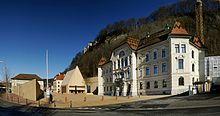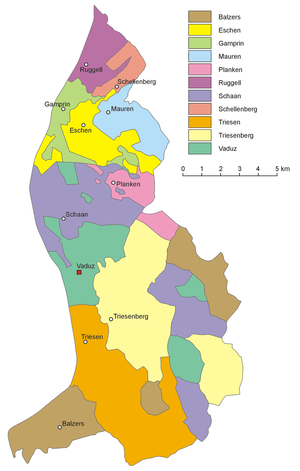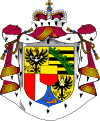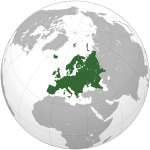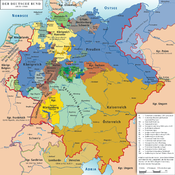- Liechtenstein
-
"Lichtenstein" redirects here. For other uses, see Lichtenstein (disambiguation).
Principality of Liechtenstein Fürstentum Liechtenstein

Flag Coat of arms Motto: Für Gott, Fürst und Vaterland
For God, Prince and FatherlandAnthem: Oben am jungen Rhein
"Up on the Young Rhine"Location of Liechtenstein (green)in Europe (dark grey) — [Legend]
Location of Liechtenstein (green)Capital Vaduz
47°08.5′N 9°31.4′E / 47.1417°N 9.5233°ELargest city Schaan Official language(s) German Demonym Liechtensteiner (male), Liechtensteinerin (female) Government Unitary parliamentary democracy and
constitutional monarchy- Prince Hans-Adam II - Regent Alois - Prime Minister Klaus Tschütscher - Landtag Speaker Arthur Brunhart Independence as principality - Treaty of Pressburg 1806 - Independence from the German Confederation 1866 Area - Total 160.475 km2 (215th)
61.960 sq mi- Water (%) negligible[1] Population - 2010 estimate 36,010[2] (209th) - 2000 census 33,307[3] - Density 224/km2 (57th)
581/sq miGDP (PPP) 2009 estimate - Total $3.409 billion[4][5] (163rd) - Per capita $95,249[4][5][6] (2nd) GDP (nominal) 2009 estimate - Total $4.797 billion[4][5] (147th) - Per capita $134,045[4][5][6] (2nd) HDI (2010)  0.891[7] (very high) (6th)
0.891[7] (very high) (6th)Currency Swiss franc ( CHF)Time zone CET (UTC+1) - Summer (DST) CEST (UTC+2) Drives on the right ISO 3166 code LI Internet TLD .li Calling code +423 The Principality of Liechtenstein (
 i/ˈlɪktənstaɪn/ lik-tən-styn; German: Fürstentum Liechtenstein, German pronunciation: [ˈfʏʁstn̩tuːm ˈlɪçtn̩ʃtaɪn][8]) is a doubly landlocked alpine country in Central Europe,[9] bordered by Switzerland to the west and south and by Austria to the east. Its area is just over 160 square kilometres (62 sq mi), and it has an estimated population of 35,000. Its capital is Vaduz. The biggest town is Schaan. Liechtenstein has the second highest gross domestic product per person in the world when adjusted by purchasing power parity,[10] and has the world's lowest external debt. Liechtenstein also has the second lowest unemployment rate in the world at 1.5% (Monaco is first).
i/ˈlɪktənstaɪn/ lik-tən-styn; German: Fürstentum Liechtenstein, German pronunciation: [ˈfʏʁstn̩tuːm ˈlɪçtn̩ʃtaɪn][8]) is a doubly landlocked alpine country in Central Europe,[9] bordered by Switzerland to the west and south and by Austria to the east. Its area is just over 160 square kilometres (62 sq mi), and it has an estimated population of 35,000. Its capital is Vaduz. The biggest town is Schaan. Liechtenstein has the second highest gross domestic product per person in the world when adjusted by purchasing power parity,[10] and has the world's lowest external debt. Liechtenstein also has the second lowest unemployment rate in the world at 1.5% (Monaco is first).Liechtenstein is the smallest yet the richest (by measure of GDP per capita) German-speaking country in the world and the only country to lie entirely within the Alps. It is the only predominantly German-speaking country not to share a common border with Germany and the only predominantly German-speaking nation to have a monarch. It is known as a principality as it is a constitutional monarchy headed by a prince. Liechtenstein is divided into 11 municipalities. Much of its terrain is mountainous, making it a winter sports destination. Many cultivated fields and small farms characterize its landscape both in the south (Oberland, upper land) and in the north (Unterland, lower land). The country has a strong financial sector located in the capital, Vaduz, and has been identified as a tax haven. It is a member of the European Free Trade Association and part of the European Economic Area but not of the European Union.
Contents
History
Main article: History of LiechtensteinAt one time, the territory was part of the ancient Roman province of Raetia. For centuries this territory, geographically removed from European strategic interests, had little impact on European history. Prior to the reign of its current dynasty, the region was enfeoffed to a line of the counts of Hohenems.
The Liechtenstein dynasty, from which the principality takes its name, comes from Castle Liechtenstein in Lower Austria, which the family possessed from at least 1140 until the 13th century, and from 1807 onward. Through the centuries, the dynasty acquired vast tracts of land, predominantly in Moravia, Lower Austria, Silesia, and Styria, though these territories were all held in fief under other more senior feudal lords, particularly under various lines of the Habsburg family, whom several Liechtenstein princes served as close advisers. Thus, without any territory held directly under the Imperial throne, the Liechtenstein dynasty was unable to meet a primary requirement to qualify for a seat in the Imperial diet (parliament), the Reichstag.
The castle of Gutenberg in Balzers
The family yearned for the added power a seat in the Imperial government would bring and therefore sought to acquire lands that would be unmittelbar, or held without any feudal personage other than the Holy Roman Emperor having rights on the land. After some time, the family was able to arrange the purchase of the minuscule Herrschaft ("Lordship") of Schellenberg and county of Vaduz (in 1699 and 1712 respectively) from the Hohenems. Tiny Schellenberg and Vaduz had exactly the political status required: no feudal lord other than their comital sovereign and the suzerain Emperor.
On 23 January 1719, after the lands had been purchased, Charles VI, Holy Roman Emperor, decreed that Vaduz and Schellenberg were united and elevated the newly formed territory to the dignity of Fürstentum (principality) with the name "Liechtenstein" in honour of "[his] true servant, Anton Florian of Liechtenstein". It was on this date that Liechtenstein became a sovereign member state of the Holy Roman Empire. It is a testament to the pure political expediency of the purchases that the Princes of Liechtenstein did not set foot in their new principality for over 120 years.
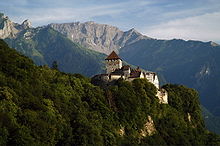 Vaduz Castle, overlooking the capital, is still home to the Prince of Liechtenstein
Vaduz Castle, overlooking the capital, is still home to the Prince of Liechtenstein
As a result of the Napoleonic Wars, by 1806 much of the Holy Roman Empire was under the effective control of French emperor Napoleon I. When the empire was dissolved, this had broad consequences for Liechtenstein: imperial, legal and political mechanisms broke down. The state ceased to owe obligations to any feudal lord beyond its borders.
Modern publications generally attribute Liechtenstein's sovereignty to these events. Its prince ceased to owe obligations to any suzerain. From 25 July 1806 when the Confederation of the Rhine was founded, the Prince of Liechtenstein was a member, in fact a vassal of its hegemon, styled protector, French Emperor Napoleon I, until the dissolution of the confederation on 19 October 1813.
Soon afterward, Liechtenstein joined the German Confederation (20 June 1815 – 24 August 1866) which was presided over by the Emperor of Austria.
Then, in 1818, Johann I granted the territory a limited constitution. 1818 also saw the first visit of a member of the house of Liechtenstein, Prince Alois; however, the first visit by a sovereign prince would not occur until 1842.
Developments during the 19th century included:
- In 1836, the first factory was opened, making ceramics.
- In 1861, the Savings and Loans Bank was founded, as was the first cotton-weaving mill.
- Two bridges over the Rhine were built in 1868, and in 1872 a railway line across Liechtenstein was constructed.
20th century
Until the end of World War I, Liechtenstein was closely tied first to the Austrian Empire and later to Austria-Hungary; the ruling princes continued to derive much of their wealth from estates in the Habsburg territories, and they spent much of their time at their two palaces in Vienna. The economic devastation caused by this war forced the country to conclude a customs and monetary union with its other neighbour, Switzerland. Liechtenstein's army was disbanded in 1868 for financial reasons.
At the time of the dissolution of the Austro-Hungarian Empire, it was argued that Liechtenstein, as a fief of the Holy Roman Empire, was no longer bound to the emerging independent state of Austria, since the latter did not consider itself as the legal successor to the empire. This is partly contradicted by the coeval Liechtenstein perception that the dethroned Austro-Hungarian Emperor still maintained an abstract heritage of the Holy Roman Empire.
In early 1938, just after the annexation of Austria into Greater Nazi Germany, 84 year old Prince Franz I abdicated, naming his 31-year-old third cousin, Prince Franz Joseph, as his successor. His wife Elisabeth von Gutmann, whom he had married in 1929, was a wealthy Jewish woman from Vienna, and local Liechtenstein Nazis had already identified her as their Jewish "problem". Although Liechtenstein had no official Nazi party, a Nazi sympathy movement had been simmering for years within its National Union party.[11]
During World War II, Liechtenstein remained officially neutral, looking to neighboring Switzerland for assistance and guidance, while family treasures within the war zone were taken to Liechtenstein for safekeeping. At the close of the conflict, Czechoslovakia and Poland, acting to seize what they considered to be German possessions, expropriated the entirety of the Liechtenstein dynasty's hereditary lands and possessions in Bohemia, Moravia, and Silesia – the princes of Liechtenstein lived in Vienna until the Anschluss of 1938. The expropriations (subject to modern legal dispute at the International Court of Justice) included over 1,600 km2 (618 sq mi) of agricultural and forest land, and several family castles and palaces.
Citizens of Liechtenstein were forbidden to enter Czechoslovakia during the Cold War. More recently the diplomatic conflict revolving around the controversial post-war Beneš decrees resulted in Liechtenstein not sharing international relations with the Czech Republic or Slovakia. Diplomatic relations were established between Liechtenstein and the Czech Republic on 13 July 2009,[12][13][14] and with Slovakia on 9 December 2009.[15]
Liechtenstein gave asylum to about 501 soldiers of the First Russian National Army (a collaborationist Russian force within the German Wehrmacht) at the close of World War II. About 200 of the group somewhat voluntarily agreed to return to the USSR. They departed in a train to Vienna and nothing was ever heard of them again. The remainder stayed in Liechtenstein for another year, resisting with support of Liechtenstein further pressure by the Soviet government to participate in the repatriation program. Eventually the government of Argentina offered asylum, and about a hundred people left. This is commemorated by a monument at the border town of Hinterschellenberg. In contrast, the British and Americans repatriated the Russians who had fought for Germany to the USSR, and many of them perished in the Gulag.
In dire financial straits following the war, the Liechtenstein dynasty often resorted to selling family artistic treasures, including the portrait "Ginevra de' Benci" by Leonardo da Vinci, which was purchased by the National Gallery of Art of the United States in 1967. Liechtenstein prospered, however, during the decades following, as it used its low corporate tax rates to draw many companies to the country.
The Prince of Liechtenstein is the world's sixth wealthiest leader with an estimated wealth of USD $5 billion.[16] The country's population enjoys one of the world's highest standards of living.
Government
Main article: Politics of LiechtensteinLiechtenstein is governed under a Constitutional monarchy. It has a form of mixed constitution, in which power is shared by the monarch and an elected parliament. The Constitution of Liechtenstein was adopted in March 2003, replacing the previous 1921 constitution which had established Liechtenstein as a constitutional monarchy headed by the reigning prince of the Princely House of Liechtenstein. A parliamentary system had been established, although the reigning Prince retained substantial political authority.
The reigning Prince is the head of state and represents Liechtenstein in its international relations (although Switzerland has taken responsibility for much of Liechtenstein's diplomatic relations). The Prince may veto laws adopted by parliament. The Prince can call referendums, propose new legislation, and dissolve parliament, although dissolution of parliament may be subject to a referendum.[17]
Executive authority is vested in a collegiate government comprising the head of government (prime minister) and four government councilors (ministers). The head of government and the other ministers are appointed by the Prince upon the proposal and concurrence of parliament, thus reflecting the partisan balance of parliament. The constitution stipulates that at least two members of the government be chosen from each of the two regions.[18] The members of the government are collectively and individually responsible to parliament; parliament may ask the Prince to remove an individual minister or the entire government.
Legislative authority is vested in the unicameral Landtag made up of 25 members elected for maximum four-year terms according to a proportional representation formula. Fifteen members are elected from the "Oberland" (Upper Country or region) and ten members are elected from the "Unterland" (Lower Country or region).[19] Parties must receive at least 8% of the national vote to win seats in parliament. Parliament proposes and approves a government, which is formally appointed by the Prince. Parliament may also pass votes of no confidence in the entire government or individual members.
Parliament elects from among its members a "Landesausschuss" (National Committee) made up of the president of the parliament and four additional members. The National Committee is charged with performing parliamentary oversight functions. Parliament can call for referendums on proposed legislation. Parliament shares the authority to propose new legislation with the Prince and with the number of citizens required for an initiative referendum.[20]
Judicial authority is vested in the Regional Court at Vaduz, the Princely High Court of Appeal at Vaduz, the Princely Supreme Court, the Administrative Court, and the State Court. The State Court rules on the conformity of laws with the constitution and has five members elected by parliament.
On 1 July 1984, Liechtenstein became the last country in Europe to grant women the right to vote. The referendum on women's suffrage, in which only men were allowed to participate, passed with 51.3% in favor.[21]
New constitution
In a national referendum in March 2003, nearly two-thirds of the electorate voted in support of Hans-Adam II's proposed new constitution to replace the 1921 one. The proposed constitution was criticised by many, including the Council of Europe, as expanding the powers of the monarchy (continuing the power to veto any law, and allowing the Prince to dismiss the government or any minister). The Prince threatened that if the constitution failed, he would, among other things, convert some of the royal property for commercial use and move to Austria.[22] The royal family and the Prince enjoy tremendous public support inside the nation, and the resolution passed with about 64% in favour.
Geography
Main article: Geography of LiechtensteinLiechtenstein is situated in the Upper Rhine valley of the European Alps and is bordered to the east by Austria and to the south and west by Switzerland. The entire western border of Liechtenstein is formed by the Rhine. Measured south to north the country is about 24 km (15 mi) long. Its highest point, the Grauspitz, is 2,599 m (8,527 ft). Despite its Alpine location, prevailing southerly winds make the climate of Liechtenstein comparatively mild. In winter, the mountain slopes are well suited to winter sports.
New surveys using more accurate measurements of the country's borders in 2006 have set its area at 160 km2 (61.776 sq mi), with borders of 77.9 km (48.4 mi).[23] Thus, Liechtenstein discovered in 2006 that its borders are 1.9 km (1.2 mi) longer than previously thought.[24]
Liechtenstein is one of only two doubly landlocked countries in the world[25]—being a landlocked country wholly surrounded by other landlocked countries (the other is Uzbekistan). Liechtenstein is the sixth-smallest independent nation in the world by land area.
The principality of Liechtenstein is divided into 11 communes called Gemeinden (singular Gemeinde). The Gemeinden mostly consist only of a single town or village. Five of them (Eschen, Gamprin, Mauren, Ruggell, and Schellenberg) fall within the electoral district Unterland (the lower county), and the remainder (Balzers, Planken, Schaan, Triesen, Triesenberg, and Vaduz) within Oberland (the upper county).
Economy
Main article: Economy of LiechtensteinDespite (or perhaps because of) its limited natural resources, Liechtenstein is one of the few countries in the world with more registered companies than citizens; it has developed a prosperous, highly industrialized free-enterprise economy and boasts a financial service sector as well as a living standard which compares favorably with those of the urban areas of Liechtenstein's large European neighbours.
Very low business taxes (lowest in Europe)—the maximum tax rate is 20%[26]—as well as easy Rules of Incorporation have induced about 73,700 holding (or so-called 'letter box') companies to establish registered offices in Liechtenstein. This provides about 30% of Liechtenstein's state revenue. Liechtenstein also generates revenue from Stiftungen ("foundations"), which are financial entities created to increase the privacy of nonresident foreigners' financial holdings. The foundation is registered in the name of a Liechtensteiner, often a lawyer.
Recently, Liechtenstein has shown strong determination to prosecute international money-launderers and has worked to promote the country's image as a legitimate finance center. In February 2008, the country's LGT Bank was implicated in a tax-fraud scandal in Germany, which strained the ruling family's relationship with the German government. Crown Prince Alois has accused the German government of trafficking in stolen goods. This refers to its $7.3 million purchase of private banking information illegally offered by a former employee of LGT Group.[27][28] However, the United States Senate's subcommittee on tax haven banks said that the LGT bank, which is owned by the royal family, and on whose board they serve, "is a willing partner, and an aider and abettor to clients trying to evade taxes, dodge creditors or defy court orders."[29]
Liechtenstein participates in a customs union with Switzerland and employs the Swiss franc as national currency. The country imports about 85% of its energy. Liechtenstein has been a member of the European Economic Area (an organization serving as a bridge between the European Free Trade Association (EFTA) and the European Union) since May 1995. The government is working to harmonize its economic policies with those of an integrated Europe. Since 2002, Liechtenstein's rate of unemployment has doubled. In 2008, it stood at 1.5%. Currently, there is only one hospital in Liechtenstein, the Liechtensteinisches Landesspital in Vaduz. The gross domestic product (GDP) on a purchasing power parity basis is $5.028 billion,[25] or $141,100 per person which in the second highest in the world.
Liechtenstein is a large producer of ceramics and is the world's largest producer of sausage casings, potassium storage units and false teeth. Other industries include electronics, textiles, precision instruments, metal manufacturing, power tools, anchor bolts, calculators, pharmaceuticals, and food products. Its most recognizable international company and largest employer is Hilti, a manufacturer of direct fastening systems and other high-end power tools. Liechtenstein produces wheat, barley, corn, potatoes, dairy products, livestock, and wine. Tourism accounts for a large portion of the country's economy.
Taxation
The government of Liechtenstein taxes both personal and business income and principal (wealth). The basic rate of personal income tax is 1.2%. When combined with the additional income tax imposed by the communes, the combined income tax rate is 17.82%.[30] An additional income tax of 4.3% is levied on all employees under the country's social security programme. This rate is higher for the self-employed, up to a maximum of 11%, making the maximum income tax rate about 29% in total. The basic tax rate on wealth is 0.06% per annum, and the combined total rate is 0.89%. The maximum business income tax rate is 18–20%.[25]
Liechtenstein's gift and estate taxes vary depending on the relationship the recipient has to the giver and the amount of the inheritance. The tax ranges between 0.5% and 0.75% for spouses and children and 18% to 27% for non-related recipients. The estate tax is progressive.
The 2008 Liechtenstein tax affair is a series of tax investigations in numerous countries whose governments suspect that some of their citizens may have evaded tax obligations by using banks and trusts in Liechtenstein; the affair broke open with the biggest complex of investigations ever initiated for tax evasion in the Federal Republic of Germany.[31] It was also seen as an attempt to put pressure on Liechtenstein, then one of the remaining uncooperative tax havens — along with Andorra and Monaco — as identified by the Paris-based Organisation for Economic Co-operation and Development in 2007.[32] On 27 May 2009 the OECD removed Liechtenstein from the blacklist of uncooperative countries.[33]
In August 2009, the British Government Department, HM Revenue & Customs, agreed with the Alpine tax haven to start exchanging information. It is believed that up to 5,000 British investors have roughly £3 billion stashed in accounts and trusts in the country.[34]
Demographics
Main article: Demographics of LiechtensteinLiechtenstein is the fourth smallest country of Europe, after Vatican City, Monaco, and San Marino. Its population is primarily Alemannic-speaking, although its resident population is approximately one third foreign-born, primarily German speakers from Germany, Austria, and Switzerland, other Swiss, Italians, and Turks. Foreign-born people make up two-thirds of the country's workforce.[citation needed]
The official language is German; most speak Alemannic, a dialect of German that is highly divergent from Standard German but closely related to those dialects spoken in neighbouring regions such as Vorarlberg, Austria. In Triesenberg, a dialect promoted by the municipality is spoken. According to the 2000 census, 87.9% of the population is Christian, of whom 78.4% adhere to the Roman Catholic faith, while about 8% are Protestant. Compared to the 1990 census, the percentage of Christians fell, whereas Muslims and the undeclared more than doubled in size.[35] According to a 2009 Pew Research Center report, Muslims constitute approximately 4.8% of the population.[36]
Religion [37] 2000 1990 Catholics 78.4 % 84.9 % Reformed Church 7.9% 9.4 % Christian-Orthodox Churches 1.1% 0.7 % Other Christian Churches 0.4% 0.1 % Muslims 4.8% 2.4 % Jews 0.1% 0.0 % Other religions 0.3% 0.1 % Undeclared / no religion 7.0 % 2.4 % Total: 100% 100% Liechtensteiners have an average life expectancy at birth of 80.31 years, male: 76.86 years, female: 83.77 years (2011 est.). The infant mortality rate is 4.64 deaths per 1,000 live births, according to recent estimates. The literacy rate of Liechtenstein is 100%.[25] The Programme for International Student Assessment, coordinated by the OECD, currently ranks Liechtenstein's education as the 10th best in the world.[38]
Transport
There are about 250 km (155 mi) of paved roadway within Liechtenstein, with 90 km (56 mi) of marked bicycle paths.
9.5 km (5.9 mi) of railway connects Austria and Switzerland through Liechtenstein. The country's railways are administered by the Austrian Federal Railways as part of the route between Feldkirch, Austria, and Buchs, Switzerland. Liechtenstein is nominally within the Austrian Verkehrsverbund Vorarlberg[39] tariff region. There are four stations in Liechtenstein, namely Schaan-Vaduz, Forst Hilti, Nendeln, and Schaanwald, served by an irregularly stopping train service that runs between Feldkirch and Buchs provided by the Austrian Federal Rail Service. While EuroCity and other long distance international trains also travel along the route, they do not normally stop at the stations within the borders of Liechtenstein.
Liechtenstein Bus is a subsidiary of the Swiss Postbus system, but separately run, and connects to the Swiss bus network at Buchs and at Sargans. Buses also run to the Austrian town of Feldkirch.
Liechtenstein has no airport; the nearest large airport is Zürich Airport near Zürich, Switzerland. There is a small heliport at Balzers[40][41] available for chartered helicopter flights.
Culture
See also: Music of Liechtenstein City-centre with Kunstmuseum (Liechtenstein Art Museum)
City-centre with Kunstmuseum (Liechtenstein Art Museum)
As a result of its small size, Liechtenstein has been strongly affected by external cultural influences, most notably those originating in the southern German-speaking areas of Europe, including Austria, Bavaria, Switzerland, and specifically Tirol and Vorarlberg. The "Historical Society of the Principality of Liechtenstein" plays a role in preserving the culture and history of the country.
The largest museum is the Kunstmuseum Liechtenstein, an international museum of modern and contemporary art with an important international art collection. The building by the Swiss architects Morger, Degelo and Kerez is a landmark in Vaduz. It was completed in November 2000 and forms a "black box" of tinted concrete and black basalt stone. The museum collection is also the national art collection of Liechtenstein.
The other important museum is the Liechtenstein National Museum (Liechtensteinisches Landesmuseum) showing permanent exhibition on the cultural and natural history of Liechtenstein as well as special exhibitions. There is also a stamp museum and a ski museum.
The most famous historical sites are Vaduz Castle, Gutenberg Castle, the Red House and the ruins of Schellenberg.
Music and theatre are an important part of the culture. There are numerous music organizations such as the Liechtenstein Musical Company, the annual Guitar Days and the International Josef Gabriel Rheinberger Society, which play in two main theatres.
"In all my travels, there is no country better than Liechtenstein, and no music better than that made by Liechtenstein's Lords." - Sir John Mandeville, The Travels of Sir John Mandeville
The Private Art Collection of the Prince of Liechtenstein, one of the world's leading private art collections, is shown at the Liechtenstein Museum in Vienna.
Amateur radio is a hobby of some nationals and visitors. However, unlike virtually every other sovereign nation, Liechtenstein does not have its own ITU Prefix. It uses Switzerland's callsign prefixes (typically "HB") followed by a zero.
Sports
See also: Rugby union in Liechtenstein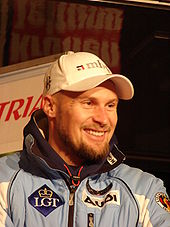 Marco Büchel, the first Alpine skier to compete at six Winter Olympics.
Marco Büchel, the first Alpine skier to compete at six Winter Olympics.
Liechtenstein football teams play in the Swiss football leagues. The Liechtenstein Football Cup allows access for one Liechtenstein team each year to the UEFA Europa League; FC Vaduz, a team playing in the Swiss Challenge League, the second division in Swiss football, is the most successful team in the Cup, and scored their greatest success in the European Cup Winners' Cup in 1996 when they tied and defeated the Latvian team FC Universitate Riga by 1–1 and 4–2, to go on to a lucrative fixture against Paris St Germain, which they lost 0–4 and 0–3.
The Liechtenstein national football team is regarded as an easy target for any team drawn against them; this was the basis for a book about Liechtenstein's unsuccessful qualifying campaign for the 2002 World Cup by British author, Charlie Connelly. In one surprising week during autumn 2004, however, the team managed a 2–2 draw with Portugal, who only a few months earlier had been the losing finalists in the European Championships. Four days later, the Liechtenstein team traveled to Luxembourg, where they defeated the home team 4-0 in a 2006 World Cup qualifying match. In the qualification stage of the European Championship 2008, Liechtenstein beat Latvia 1-0, a result which prompted the resignation of the Latvian coach. They went on to beat Iceland 3-0 on 17 October 2007, which is considered one of the most dramatic losses of the Icelandic national football team. On 7 September 2010, they came within seconds of a 1–1 draw against Scotland in Glasgow, having led 1–0 earlier in the second half, but Liechtenstein lost 2–1 thanks to a goal by Stephen McManus in the 97th minute. On 3 June 2011, Liechtenstein defeated Lithuania 2-0.
As an alpine country, the main sporting opportunity for Liechtensteiners to excel is in winter sports such as downhill skiing: the country's single ski area is Malbun. Hanni Wenzel won two gold medals and one silver medal in the 1980 Winter Olympics (she won bronze in 1976), and her brother Andreas won one silver medal in 1980 and one bronze medal in 1984 in the giant slalom event. With nine medals overall (all in alpine skiing), Liechtenstein has won more Olympic medals per capita than any other nation.[42] It is the smallest nation to win a medal in any Olympics, Winter or Summer, and the only nation to win a medal in the Winter Games but not in the Summer Games. Other notable skiers from Liechtenstein are Marco Büchel, Willi Frommelt, Paul Frommelt and Ursula Konzett.
Security and defense
The Liechtenstein National Police is responsible for keeping order within the country. It consists of 87 field officers and 38 civilian staff totaling 125 employes. All officers are equipped with small arms. The country has one of the world's lowest crime rates. Liechtenstein's prison holds few, if any, inmates, and those with sentences over two years are transferred to Austrian jurisdiction. The Liechtenstein National Police maintains a trilateral treaty with Austria and Switzerland that enables close cross-border cooperation among the police forces of the three countries.[43]
Liechtenstein follows a policy of neutrality and is one of few countries in the world that maintains no military. The army was abolished soon after the Austro-Prussian War in which Liechtenstein fielded an army of 80 men, although they were not involved in any fighting. The demise of the German Confederation in that war freed Liechtenstein from its international obligation to maintain an army, and parliament seized this opportunity and refused to provide funding for one. The Prince objected, as such a move would leave the country defenseless, but relented on 12 February 1868 and disbanded the force. The last soldier to serve under the colours of Liechtenstein died in 1939 at age 95.[44]
In March 2007, a 170-person Swiss infantry unit became lost during a training exercise and inadvertently crossed 1.5 km into Liechtenstein. The accidental invasion ended when the unit realized their mistake, and turned back.[45] The Swiss army later informed Liechtenstein of the incursion and offered official apologies.[46]
References
- ^ Raum, Umwelt und Energie, Landesverwaltung Liechtenstein. Accessed on 2 October 2011
- ^ Bevölkerungsstatistik 30. Juni 2010, Landesverwaltung Liechtenstein. Accessed on 2 October 2011
- ^ Bevölkerungsstruktur - Band 1, Liechtensteinische Volkszählung 2000, Landesverwaltung Liechtenstein. Accessed on 2 October 2011.
- ^ a b c d Key Figures for Liechtenstein, Landesverwaltung Liechtenstein. Accessed on 2 October 2011.
- ^ a b c d World Development Indicators, World Bank. Accessed on 2 October 2011. Note: "PPP conversion factor, GDP (LCU per international $)" and "Official exchange rate (LCU per US$, period average)" for Switzerland were used.
- ^ a b Bevölkerungsstatistik 30. Juni 2009, Landesverwaltung Liechtenstein. Accessed on 2 October 2011.
- ^ "Human Development Report 2010". United Nations. 2010. http://hdr.undp.org/en/media/HDR_2010_EN_Complete.pdf. Retrieved 4 November 2010.[dead link]
- ^ Duden Aussprachewörterbuch, s.v. "Liechtenstein[er]".
- ^ http://www.springerlink.com/content/p4308k60457x3n41/
- ^ CIA – The World Factbook – Country Comparison :: GDP – per capita (PPP)
- ^ "LIECHTENSTEIN: Nazi Pressure?". TIME. 1938-04-11. http://www.time.com/time/magazine/article/0,9171,759431,00.html. Retrieved 2010-05-26.
- ^ "Liechtenstein and the Czech Republic establish diplomatic relations" (PDF). Government Spokesperson’s Office, the Principality of Liechtenstein. 2009-07-13. http://88.82.102.51/fileadmin/_pm.liechtenstein.li/en/090713_PM_Beziehungen_CzFl_en.pdf. Retrieved 2009-08-06.
- ^ "Navázání diplomatických styků České republiky s Knížectvím Lichtenštejnsko" (in Czech). Ministry of Foreign Affairs of the Czech Republic. 2009-07-13. http://www.mzv.cz/jnp/cz/udalosti_a_media/prohlaseni_a_stanoviska/archiv_prohlaseni_a_stanovisek/archiv_2009/x2009_07_13_lilchtejnstejnsko_navazani_diplomatickych_vztahu.html. Retrieved 2011-10-28.
- ^ "MINA Breaking News – Decades later, Liechtenstein and Czechs establish diplomatic ties". Macedoniaonline.eu. 2009-07-15. http://macedoniaonline.eu/content/view/7526/1/. Retrieved 2010-06-06.
- ^ "Liechtenstein and the Slovak Republic establish diplomatic relations" (PDF). Government Spokesperson’s Office, the Principality of Liechtenstein. 2009-12-09. http://88.82.102.51/fileadmin/_pm.liechtenstein.li/en/091209_Beziehungen_SKFL_en.pdf. Retrieved 2009-12-22.
- ^ D. Pendleton, C. Vorasasun, C. von Zeppelin, T. Serafin(1 September 2008). "The Top 15 Wealthiest Royals". Forbes Magazine.
- ^ Country profile: Liechtenstein - Leaders BBC News, 6 December 2006. Retrieved 29 December 2006.
- ^ Principality of Liechtenstein – Government. Retrieved 11 January 2010.
- ^ Principality of Liechtenstein website – Parliamentary elections. Retrieved 11 January 2010.
- ^ Principality of Liechtenstein website – Parliamentary Organization. Retrieved 11 January 2010.
- ^ "Liechtenstein Women Win Right to Vote" The New York Times, 2 July 1984. Retrieved 8 July 2011.
- ^ Liechtenstein Prince wins powers BBC News Online, 16 March 2003. Retrieved 29 December 2006.
- ^ "Tiny Liechtenstein gets a little bigger", 29 December 2006.
- ^ Liechtenstein redraws Europe map, BBC News, 28 December 2006.
- ^ a b c d CIA World Factbook – Liechtenstein.
- ^ [1]
- ^ Wiesmann, Gerrit. "Lilliput's giant-slayer." The Financial Times, 23 February 2008.
- ^ A Parasite's Priorities, 22 February 2008.
- ^ "Four Corners – 06/10/2008: Tax Me If You Can". Abc.net.au. 2008-10-06. http://www.abc.net.au/4corners/content/2008/s2383439.htm. Retrieved 2010-06-06.
- ^ Encyclopedia of the Nations
- ^ "Skandal gigantischen Ausmaßes" (in German). Süddeutsche Zeitung. 2008-02-15. http://www.sueddeutsche.de/,tt2m2/wirtschaft/artikel/599/158176/. Retrieved 2008-02-21.[dead link]
- ^ Esterl, Mike; Simpson, Glenn R., Crawford, David (2008-02-19). "Stolen Data Spur Tax Probes". The Wall Street Journal (Google Groups). http://groups.google.com/group/alt.lawyers/browse_thread/thread/6782128a239af406/67aab034a3fcf850. Retrieved 2008-02-20.
- ^ Removal from OECD List of Unco-operative Tax Havens
- ^ British Broadcasting Corporation
- ^ Publikationen zur Volkszählung 2000 – Amt für Volkswirtschaft (AVW) – Landesverwaltung Liechtenstein<
- ^ http://pewforum.org/uploadedfiles/Topics/Demographics/Muslimpopulation.pdf
- ^ Publikationen zur Volkszählung 2000 – Amt für Volkswirtschaft – Landesverwaltung Liechtenstein
- ^ Range of rank on the PISA 2006 science scale
- ^ Verkehrsverbund Vorarlberg
- ^ Heliport Balzers FL LSXB
- ^ Heliports – Balzers LSXB – Heli-Website von Matthias Vogt
- ^ "Per Capita Olympic Medal Table". http://users.skynet.be/hermandw/olymp/reloly.html. Retrieved 2009-01-24.
- ^ Liechtenstein – facts and figures retrieved from here [2] on May 9, 2007
- ^ Beattie, David (2004). Liechtenstein: A Modern History. London: I.B. Tauris. p. 30. ISBN 1-85043-459-X.
- ^ CBC News (2 March 2007). "Not-so-precise Swiss army unit mistakenly invades Liechtenstein". CBC News. http://www.cbc.ca/news/world/story/2007/03/02/swissinvade.html. Retrieved 18 September 2011.
- ^ Hamilton, Lindsay (3 March 2007). "Whoops! Swiss Accidentally Invade Liechtenstein". ABC News. http://abcnews.go.com/International/story?id=2921407&page=1. Retrieved 18 September 2011.
External links
- The Principality of Liechtenstein
- The Princely House of Liechtenstein
- Statistics Liechtenstein (German)
- Parliament
- Tourism Liechtenstein
- National Art Museum of Liechtenstein
- Liechtenstein entry at The World Factbook
- Liechtenstein at the Open Directory Project
- Wikimedia Atlas of Liechtenstein
- Liechtenstein travel guide from Wikitravel
 OpenStreetMap has geographic data related to Liechtenstein
OpenStreetMap has geographic data related to Liechtenstein
Liechtenstein Politics History Background · Werdenberg · Liechtenstein Castle · Vaduz Castle · Princely family · Confederation of the Rhine · German Confederation · 1862 Constitution · 2008 tax affairOther topics Geography · Mountains · Rivers · Municipalities · Economy · Currency · Communications · Postal history · Culture · Demographics · Languages · Media · Music · Sports · Religion · Flag · Anthem · Public holidaysOutline · Portal International organizations Council of Europe Institutions Secretary General · Committee of Ministers · Parliamentary Assembly · Congress · Court of Human Rights · Commissioner for Human Rights · Commission for the Efficiency of Justice · Commission against Racism and Intolerance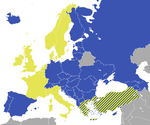
Members FullAlbania · Andorra · Armenia · Austria · Azerbaijan · Belgium · Bosnia and Herzegovina · Bulgaria · Croatia · Cyprus · Czech Republic · Denmark · Estonia · Finland · France · Georgia · Germany · Greece · Hungary · Iceland · Ireland · Italy · Latvia · Liechtenstein · Lithuania · Luxembourg · Macedonia1 · Malta · Moldova · Monaco · Montenegro · Netherlands · Norway · Poland · Portugal · Romania · Russia · San Marino · Serbia · Slovakia · Slovenia · Spain · Sweden · Switzerland · Turkey · Ukraine · United KingdomObserverFormer1 Provisionally referred to by the Council of Europe as "the former Yugoslav Republic of Macedonia"; see Macedonia naming dispute. Members of the European Free Trade Association (EFTA) - Iceland
- Liechtenstein
- Norway
- Switzerland
Monarchies List of current sovereign monarchs · List of current constituent monarchs By continent By country Antigua and Barbuda · Australia · Andorra · The Bahamas · Bahrain · Barbados · Belize · Belgium · Bhutan · Brunei · Cambodia · Canada · Denmark · Grenada · Jamaica · Japan · Jordan · Kuwait · Liechtenstein · Lesotho · Luxembourg · Malaysia · Monaco · Morocco · Netherlands · New Zealand · Norway · Oman · Papua New Guinea · Qatar · Spain · Saint Kitts and Nevis · Saint Lucia · Saint Vincent and the Grenadines · Saudi Arabia · Solomon Islands · Swaziland · Sweden · Thailand · Tonga · Tuvalu · United Arab Emirates · United Kingdom · Vatican CityBy type Italics indicate Commonwealth realms, which each share the same person as head of state. Categories:- Liechtenstein
- European countries
- Landlocked countries
- Alpine countries
- Principalities
- German-speaking countries
- Constitutional monarchies
- Liberal democracies
- States of the German Confederation
- States of the Confederation of the Rhine
- States of the Holy Roman Empire
- NUTS 1 statistical regions of the European Union
- NUTS 2 statistical regions of the European Union
- NUTS 3 statistical regions of the European Union
- States and territories established in 1866
- Western Europe
- Member states of the United Nations
Wikimedia Foundation. 2010.

![Location of Liechtenstein (green)in Europe (dark grey) — [Legend]](/pictures/enwiki/50/250px-Location_Liechtenstein_Europe.png)





